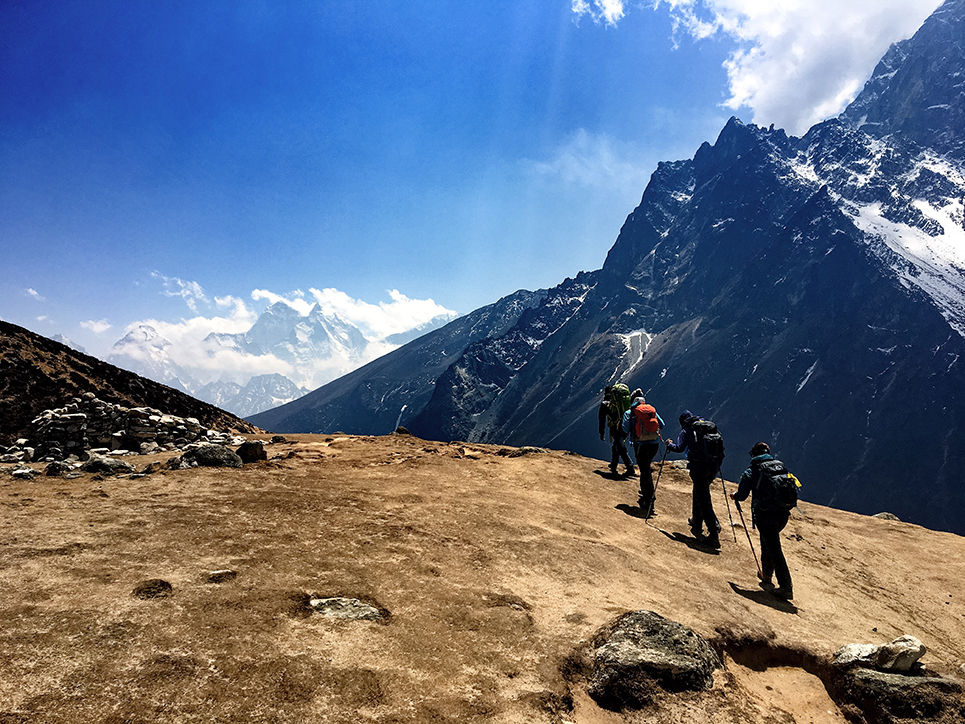Conquer Everest’s Three High Passes The Ultimate Sherpa Expedition
Because that’s where the real adventure happens on the Conquer Everest’s Three High Passes235 Ultimate Sherpa Expedition. Suitable for those crazy trekking enthusiasts, this adventure challenges the trekkers to their maximum, not just physically but also mentally. Confluence Trek traverses the series of three major high passes of the Everest region namely Renjo La, Cho La, and Kongma La. Every pass presents its own challenges along the way, including majestic views of snow-capped mountains, deep valleys, and ancient monasteries hidden away in the remote Himalayas.
The journey starts in Lukla, a small town in the heart of the Khumbu region, and steadily climbs through Sherpa villages, dense forests, and alpine meadows. From the first pass, Renjo La, trekkers are greeted with breathtaking panoramas of Everest, Makalu , and other impressive mountains. The inhospitable environment and altitude require tenacity, but the view from the top of each pass is well worth it. The second, Cho La, has its challenges, a steep, rugged climb that hits at your endurance, but it gives you another up close, albeit distant view of mighty Everest’s south face.
Everest Three Pass Trek The last pass, Kongma La, is said to be the hardest of the three. The journey takes place from glaciers and rocky dirt up the top get treated to views that are awe-inspiring and well worth every step of the trip. Adventurers also have the opportunity to visit famous landmarks such as the Everest Base Camp and the sacred Gokyo Lakes in the process, providing a more in-depth connection to the rich history and spiritual significance of the region.
With this expedition, if you are physically tested, you will also be introduced to the Sherpa culture and the point of view they bring to the trek through their hospitality and understanding before showing you their wisdom and resilience. Everest Three High Passes trek, offers an unparalleled adventure, combining the rich culture of the region with the breathtaking landscapes of the Himalayas, providing the ultimate challenge for trekkers looking to test their limits and witness the magnificence of the world’s highest mountains.
An Overview of Everest’s Three High Passes
The Everest Three High Passes trek is among the most invigorating and arduous treks on Earth, a rite of passage for the adventurer into the Annapurna region of Nepal. It passes over three of the highest passes in the Everest region, Kongma La, Cho La, and Renjo La. These passes, at heights of 5,300 meters to higher than 5,400 meters, offer trekkers the stunning sights of the towering Himalayan giants, like Everest, Lhots,e and Makalu. Besides the physical challenge, the trek also offers an opportunity for immersion in the culture of the Sherpa people and their traditional way of life. The challenge of the Everest Three High Passes trek is best suited for seasoned trekkers seeking an off-the-beaten-path route, where spectacular mountain scenery is complemented by the immense sense of accomplishment that comes from crossing some of the highest trekking passes in the world.
Role of the Sherpa Expedition
The Sherpa have gained significance in relation to the success of expeditions to Mt. Everest and other high-altitude climbs and are known for their resilience and strength and are deeply connected to the Himalayan landscape. Sherpas, known for their incredible navigating properties in the rough terrain of the Himalayas, have long been essential guides for both mountaineers and trekkers. They’re specialists in acclimatization, survival in extreme environments, and the maneuvers of high-altitude travel. | While many have come for the most iconic trek of them all, the strenuous trek to Everest Base Camp or the more rugged Three High Passes, others come to take in the incredible porters who carry heavy loads at high altitudes and know the terrain better than most. Not only guides, Sherpas are the lifeblood of the trekking industry, maintaining the unique culture and traditions of the region while helping trekkers have a safe and successful expedition.
A Guide to the Three High Passes
Everest Three Pass Trek itinerary: One of the most adventurous treks of the world in terms of altitude hiking. The three high mountain passes—Kongma La, Cho La, and Renjo La—are the dramatic star pieces of this strenuous circuit. The trek starts at the village of Lukla, where trekkers fly in from Kathmandu to the trailhead, en route to Namche Bazaar, the gateway to Everest. En route, trekkers cross these high-altitude passes, offering sweeping panoramas of Mount Everest, Lhotse, Makalu, and many, many more peaks. Not only does the trek challenge physical limits; but it also offers an immersive cultural experience, as those who trek along the route move through traditional Sherpa villages and Buddhist monasteries. Although the Three High Passes trek is challenging due to its remote location and high-altitude terrain, it rewards hikers with some of the most breathtaking mountain views on the planet.
The Route: Lukla to Everest Base Camp
However, most people (if not all) fly from Kathmandu to Lukla (a small town with an airport on the edge of a mountain). The path from Lukla follows the standard Everest Base Camp trail, through the Sherpa villages of Phakding and Namche Bazaar. As trekkers gain elevation, they are led to the high-altitude lands that will soon carry them through the Three High Passes. Having acclimatized in Namche Bazaar, the route now heads into tougher high passes. Trekkers stop at famous sites along the way, including the Tengboche Monastery and the settlements of Dingboche and Lobuche. The journey involves tens of kilometers of semi-technical trail, mild elevations, challenging climbs, and unpredictable weather. With sweeping vistas of Mount Everest and its surrounding peaks, it is an adventure that is every bit as rewarding as it is physically demanding and offers a unique chance to see the wonders of the Himalayas.
Navigating the Kongma La Pass
Everest Three Pass Trek cost The high Kongma La Pass, with an elevation of 5,535 meters, is the tallest of the Three High Passes and is one of the most challenging sections of the trek. The climb to the pass (called the high pass) starts at Lobuche, and the trail here is steep and laborious. Trekkers follow the trail across rocky terrain, where altitude sickness can pose a serious threat. But the effort is well worth the reward. Making it to the top of Kongma La, hikers are awarded the sprawling sight of some of the highest peaks on the planet, Everest, Lhotse, and Makalu. The climb down is just as hard, as the uneven ground must be traversed carefully. The Kongma La Pass is a challenging pass for trekkers, but also one of the most rewarding and allows you to enjoy the best perspective of the entire Everest region.
Crossing the Cho La Pass
Everest Three Pass Trek map However, Cho La Pass gives you the second of the Three High Passes, at 5,420 meters. The Cho La Pass connects Dzongla and Gorak Shep and features a steep ascent and descent, snow, and ice cover which can make it treacherous to cross at certain times of the year. Trekkers go across the pass early in the day, to escape the daily weather shift in the afternoons. The trek to Cho La requires careful attention to your footing: ice and snow can render the trail slippery. Trekkers who make their way over the pass are treated to breathtaking views of Everest, Nuptse, and Lhotse. Regarded as a real measure of endurance, the Cho La Pass offers an immense sense of achievement for those who have crossed it, which is unique in itself to stand on top of one of the high passes in the land of the Himalayas.
Hiking through the Renjo La Pass
Adventurers looking to tackle Everest’s high passes simply must trek through the Renjo La Pass! Translated from: Renjo la: 5360 meters (17,590 feet) – One of the stunning passes in the surroundings of the Khumbu region and it’s the most difficult one also. It lies along the Upper Ghombu while passing through this pass, which grants panoramic views of Mount Everest, Makalu, and many other high peaks, it is a photographer’s dream. The trek starts in the village of Gokyo and takes trekkers along a trail winding up a glacial moraine and steep landscape that will challenge their endurance and grit.
Renjo La Trail The road to Renjo La can be challenging, often requiring physical and mental acclimatization, as the pass can be a steep ascent, and the Himalayan air is thin. Upon trekking closer to the pass you are gifted with spectacular sights of the Gokyo Lakes and surrounding snow-capped mountains. The last stretch towards the top of Renjo La is exhausting, but nothing can compare to the views from up there, making it all worth it. The descent on the opposite side of the pass guides trekkers toward the village of Thame, a place where they can recharge and ponder the trek.
Less Crowded High Pass In Everest Region: Unlike the other high passes, we cross in the Everest region, Renjo La is also less crowded, which is another reason Renjo La is excellent for those who seek to have a quieter, more tranquil trekking trip, while being able to challenge themselves physically and psychologically.
Please note that this is a paraphrased sentence.
With the highest altitude, causing risks of altitude sickness, the Trekking in Everest region is an adventurous journey. It is important to use proper acclimatization strategies to ensure they are safe and that the expedition can be successfully completed. Altitude sickness, also called acute mountain sickness (AMS), is a condition that occurs when the body has a hard time adjusting to the reduced levels of oxygen that come with higher altitude. To combat this, trekkers should have a slow ascent plan, giving their bodies plenty of time to acclimatize to the different conditions.
Everest Three Pass Trek package As a general guideline, no more than 300–500 m (often cited as 300–500 m) of altitude gain per day should be achieved above 3,000 m (9,800 ft). This slow rise reduces the chances of altitude sickness. Moreover, trekkers must rest a day here and there at important locations, specifically after each 1,000-meter altitude gain, to enable the body to acclimatize adequately. The best technique is “climb high, sleep low”, meaning you can hike up to high altitude during the daytime but then come back down to a lower altitude to sleep, assisting the body in adapting better.
Both a high-calorie diet and remaining well-hydrated contribute to easing the impact of high-altitude trekking. Drugs like Diamox can reduce the symptoms of AMS, but should only be used under the guidance of a doctor. Listening to the body is vital, and in the case of persistent symptoms of altitude sickness, descending to a lower altitude is necessary for your recovery.
The Expedition’s Sherpas
They are an essential part of every trekking or mountaineering expedition in the Himalayas. Trained on data until October 2023, Lynn Anne O’Brien, Jibreel Mambayi, and Min KimSherpas, a group of mountaineers from the Nepalese Himalayas, have evolved high oxygen levels at great heights. Loggers serve as invaluable companions to trekkers, with a deep knowledge of the terrain, weather patterns, and the various dangers of high-altitude travel.
Sherpas guide trekkers over the routes, finds the best way through the challenging paths, and provide advice on acclimatization and weather. They help avoid accidents and make sure that everything goes the way it should. They also help to carry heavy loads including food, equipment, and gear, allowing trekkers to enjoy their trek more freely.
‘Not only do they have physical stamina, but they also give cultural tastings and tell you about the history and the traditions of the region,’ says the co-founder. They are known for their warmth, hospitality, and resilience, and their very presence provides a sense of security and camaraderie. Traveling with Sherpas not only makes the trek a safer journey, it enables a deeper connection with the local culture, turning what could be a solitary physical challenge into a shared experience.
Must-Have Gear and Equipment to Bring on the Trek
Everest Base Camp Three Pass Trek If you are planning a trek around the Everest region and crossing over high passes such as the Renjo La, it is difficult to be underprepared. The right gear helps to ensure safety, comfort, and the ability to deal with the region’s extreme weather. Trekking in the high Himalayas means exposure to cold temperatures, steep terrain, and the possible vagaries of unpredictable weather, so wearing the right clothes and carrying the right gear is critical.
The right clothing is the backbone of any trekker’s gear list. In high-altitude environments layering is key. Begin with moisture-wicking base layers to keep sweat off the skin, and add insulating layers like fleece or down jackets for warmth. A weather-resistant outer layer is critical for keeping out the wind, rain, or snow. Footwear is another essential — trekkers will need strong, waterproof trekking boots with plenty of ankle support along with warm socks to prevent frostbite.
Other must-haves include a quality sleeping bag that’s rated for below-freezing conditions, a four-season tent, and trekking poles to traverse uneven ground. Trekking through the passes typically requires crossing glaciers and rocky terrain, so a headlamp, spare batteries, and a first-aid kit are essential. So for communicating, a satellite phone or emergency beacon could save your life during emergencies. Trekkers also carry water purification pills or filters because you won’t always find freshwater sources.
Preparation, though, and the right equipment can mean the difference between a trek enjoyed and one tinged with discomfort or safety issues. The key to a safe and rewarding adventure lies in ensuring that every item you pack is high-quality and suited to the extreme conditions of the Himalayas.
Difficulties Encountered Throughout the Journey
While its three high passes make trekking through the Everest region a little demanding. Perhaps the biggest challenge is the brutal weather climate. In the high Himalayas, weather can shift quickly and snowstorms and subfreezing temperatures can become a true danger. Extreme cold, heavy snowfall and strong winds that make progress difficult and create dangerous conditions are realities trekkers need to be prepared for.
Another big challenge is altitude. As trekkers climb to higher altitudes, the air gives way to lower oxygen levels, and the body has to exert itself more to compensate for the loss of air. That makes the trek physically challenging, and many participants suffer from altitude sickness symptoms, including headaches, dizziness, and shortness of breath. There is a need for proper acclimatization, but even those who plan ahead carefully can find themselves facing a formidable foe (the altitude).
The terrain itself poses challenges, too. Many of the trails to get to the high passes are steep and rocky; much of it is loose gravel, and they can be treacherous to trespass on. A glacial moraine and narrow ridgelines must be carefully traversed, and trekkers must remain vigilant to avoid slips and falls. The isolation of the area also means that options for rescue are limited, and trekkers must be self-sufficient and ready for emergencies.
However, the rewards of completing the trek far outweigh these challenges. With grit, good preparation, and the help of seasoned Sherpas, trekkers can navigate these challenges and appreciate the majesty of the Everest region.
Conclusion and Tips for Future Trekking Enthusiasts
Everest Base Camp Three Pass Trek itinerary Reaching three high passes on Everest is a challenge like no other, testing the mental and physical boundaries of trekkers among the stunning splendors of the Himalayas. Weather can be brutal, and conditions please, and the exhausting trek to high altitudes all identify their share of challenges. With the right preparation, a solid acclimatization strategy, and the will to get it done, however, trekkers can conquer the challenging line and attain the high points of Renjo La, Cho La, and Kongma La.
Trekkers in the future would need to do proper planning. Pack the proper equipment, like layered clothes, durable footwear, and a high-quality sleeping bag. Acclimatization needs to be treated seriously — give your body time to adapt to the high altitudes and do not hurry up your ascent. Being mindful of your body, and its symptoms of altitude sickness can help ensure your safety.
Deciding to trek with experienced Sherpas can be a game changer. Their skills will also help trekkers get around with confidence, and their intimate knowledge of the region and its challenges provides valuable advice. Apart from that, you have to be mentally prepared that this will be a physically demanding trek, and patience is required throughout the trek to have a good time.
With the aid of these tips and the proper amounts of preparation, future trekkers can set out on an unforgettable adventure that combines physical strain, cultural exploration, and a close-up view of the majestic Everest region.











Post Comment